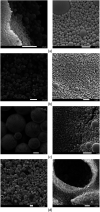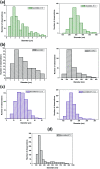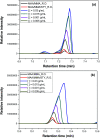Preparation of terpolymer capsules containing Rosmarinus officinalis essential oil and evaluation of its antifungal activity
- PMID: 35519452
- PMCID: PMC9067078
- DOI: 10.1039/c9ra02336d
Preparation of terpolymer capsules containing Rosmarinus officinalis essential oil and evaluation of its antifungal activity
Abstract
The essential oil from Rosmarinus officinalis presents antifungal activity and is used in industry as a natural preserving agent. However, essential oils are unstable compounds. So, the encapsulation of essential oils is a technique used to protect it, minimizing degradation and reducing undesired interaction with the other formulation components. Thus, this work focuses on the synthesis of terpolymeric capsules containing essential oil from Rosmarinus officinalis, aiming to use it as an antifungal component in cosmetics. The capsules were obtained via terpolymerization of methyl methacrylate, styrene and methacrylic acid in a dispersed phase polymerization process. The properties of the polymers and the fungicide activity were evaluated. The studied essential oil presented a Minimum Inhibitory Concentration (MIC) ranging from 2.25 to 4.5 mg mL-1 and a Minimum Fungicidal Concentration (MFC) from 4.5 to 9.0 mg mL-1 for strains of Candida albicans, Candida glabrata and Candida parapsilosis, and after the encapsulation process, the antifungal activity of the oil was maintained. Additionally, cytotoxicity assays against fibroblast cell lines and human keratinocytes showed that the polymeric nanocapsules containing Rosmarinus officinalis essential oil can be regarded as a very promising material intended for cosmetics and drug delivery applications.
This journal is © The Royal Society of Chemistry.
Conflict of interest statement
There are no conflicts to declare.
Figures















Similar articles
-
Antifungal activity of essential oils extract from Origanum floribundum Munby, Rosmarinus officinalis L. and Thymus ciliatus Desf. against Candida albicans isolated from bovine clinical mastitis.J Mycol Med. 2017 Jun;27(2):245-249. doi: 10.1016/j.mycmed.2017.03.004. Epub 2017 Apr 25. J Mycol Med. 2017. PMID: 28454927
-
Spray-Dried Proliposomes: an Innovative Method for Encapsulation of Rosmarinus officinalis L. Polyphenols.AAPS PharmSciTech. 2020 May 18;21(5):143. doi: 10.1208/s12249-020-01668-2. AAPS PharmSciTech. 2020. PMID: 32424702 Free PMC article.
-
In vitro activity of essential oils extracted from condiments against fluconazole-resistant and -sensitive Candida glabrata.J Mycol Med. 2015 Sep;25(3):213-7. doi: 10.1016/j.mycmed.2015.06.003. Epub 2015 Aug 14. J Mycol Med. 2015. PMID: 26281965
-
Antifungal and antiaflatoxigenic activity of rosemary essential oil (Rosmarinus officinalis L.) against Aspergillus flavus.Food Addit Contam Part A Chem Anal Control Expo Risk Assess. 2020 Jan;37(1):153-161. doi: 10.1080/19440049.2019.1678771. Epub 2019 Oct 23. Food Addit Contam Part A Chem Anal Control Expo Risk Assess. 2020. PMID: 31644378
-
Pharmacological and biotechnological advances with Rosmarinus officinalis L.Expert Opin Ther Pat. 2018 May;28(5):399-413. doi: 10.1080/13543776.2018.1459570. Epub 2018 Apr 10. Expert Opin Ther Pat. 2018. PMID: 29633892 Review.
Cited by
-
GC-MS Profiling and Biomedical Applications of Essential Oil of Euphorbia larica Boiss.: A New Report.Antioxidants (Basel). 2023 Mar 7;12(3):662. doi: 10.3390/antiox12030662. Antioxidants (Basel). 2023. PMID: 36978910 Free PMC article.
-
Preparation and Evaluation of Nanoemulsion of Citronella Essential Oil with Improved Antimicrobial and Anti-Cancer Properties.Antibiotics (Basel). 2023 Feb 27;12(3):478. doi: 10.3390/antibiotics12030478. Antibiotics (Basel). 2023. PMID: 36978345 Free PMC article.
References
-
- Kumar R. Shukla S. K. Pandey A. Pandey H. Pathak A. Dikshit A. Int. J. Pharm. Sci. Res. 2016;7:3218.
-
- Ojeda-Sana A. M. van Baren C. M. Elechosa M. A. Juarez M. A. Moreno S. Food Control. 2013;31:189. doi: 10.1016/j.foodcont.2012.09.022. - DOI
LinkOut - more resources
Full Text Sources

